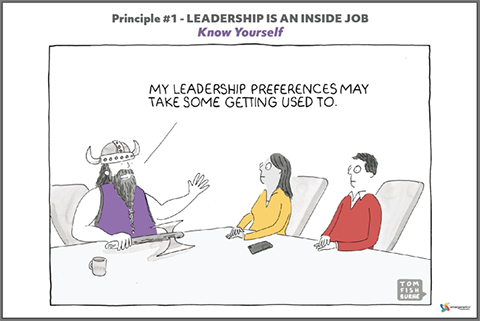
Last month, I introduced the concept of Emergineering, which, in brief, is the process of taking any business objective – like fostering innovation or driving a positive culture – and applying an Emergenetics lens to every aspect of that goal. Emergineering is a concept I explore at great length in my newly launched book: Work That Works.
If you missed it and want a more detailed explanation of the concept and why you should implement it, I encourage you to read my recent post here.
This month, as I help you work towards becoming an Emergineer at your own organization, I’d like to focus on the first principle of the book: Leadership Is an Inside Job. Know yourself.
When I first started writing about this principle, I struggled quite a bit. As you are likely well aware, thousands of research papers and articles have been written on the topic of leadership, so I felt challenged to be sure my perspective would be something original. So I thought back on the work I’ve done with leaders over the years, and what I have found from decades of partnering with organizations, training executives and reflecting on my own personal experience is that a person’s approach to leadership can be anchored by three core questions:
- Who are you?
- What do you love?
- How can you restore balance to a troubled world?
These questions help leaders gain the self-awareness to understand how they can make an impact. Let’s explore each in a bit more depth.
Who are you?
Transparency is critical to leadership and not simply because someone can look up almost anything about you on the internet. As a leader, it is important to understand who you are.
In fact, according to a study by Green Peak Partners and Cornell’s School of Industrial and Labor Relations, “a high self-awareness score was the strongest predictor of overall success” for executives. Renowned psychologist Daniel Goleman has echoed that self-awareness is a critical competency of leadership.
As you reflect on who you are, consider what is it about your behavior, your thinking, your relationships or your judgment that makes you prepared to lead others?
Until you know yourself and understand your values, roots and ethics, it can be challenging to lead others. While the journey of self-discovery does take significant time and attention, a great place to start is the Emergenetics Profile. The Profile can help you understand how you think and behave. Once you know this, you can begin to embrace what strengths you bring to your organization and team members, and how these attributes come through in your leadership.
What do you love?
When you do something you love, it often no longer feels like work.
I encourage you right now to ask yourself: “Do I love my job?”
No matter your answer, I invite you to explore why. What about your job is engaging or not engaging? What excites you? Challenges you? What strengths does it require?
When you have a list of answers, try comparing your answers to your Emergenetics Profile. Are they a match with what is reflected about the way you prefer to think and behave?
It’s okay if they are not. This exercise is simply meant to help you explore why there is or isn’t a perfect match.
I invite you, after you have completed this exercise for yourself, to ask your teammates these same questions and see how you can help them pursue a path that brings them energy and gives them a chance to pursue their passions within the company.
Please know that the type of change I would advocate for might not require you to find a new job. I believe that clearly defining your leadership intentions and putting them into action can help foster affection for professional opportunities that are already in front of you. The key is to work from the inside out to find out where your priorities lie.
How can you restore balance to a troubled world?
Restoring balance does not just mean volunteering or engaging in non-profit work. While I firmly believe in the importance of doing these things (and scientific evidence supports this), leaders should also consider how they will bring balance to themselves.
As a leader, if you have not brought your own life into balance, how can you expect to support others in your team, company, community or home?
When you have looked inwards, faced your fears and accepted challenges, others can sense it and will ask for your guidance.
After walking through this personal journey, the world itself seems less out of balance and not as threatening.
More and more, a company’s value is seen not so much in terms of its balance sheet as its human capital. As a leader, it is your role to provide stewardship to your employees and create an organization where individuals and teams are able and encouraged to thrive.
Once you have gained self-awareness, are pursuing what you love and have brought balance to yourself that is when you can become a more effective leader of others.
I encourage you to consider these questions over the next few weeks. The New Year is a fine time to think about leadership from a fresh perspective!
And don’t forget to be on the lookout for my next blog, which will feature the second principle of the book: Embrace the Scratchy! Uncomfortable is the New Normal. If you cannot wait for the next post and would like to learn more now, I encourage you to pick up a copy of Work That Works to explore each of the seven principles!
 Print This Post
Print This Post
